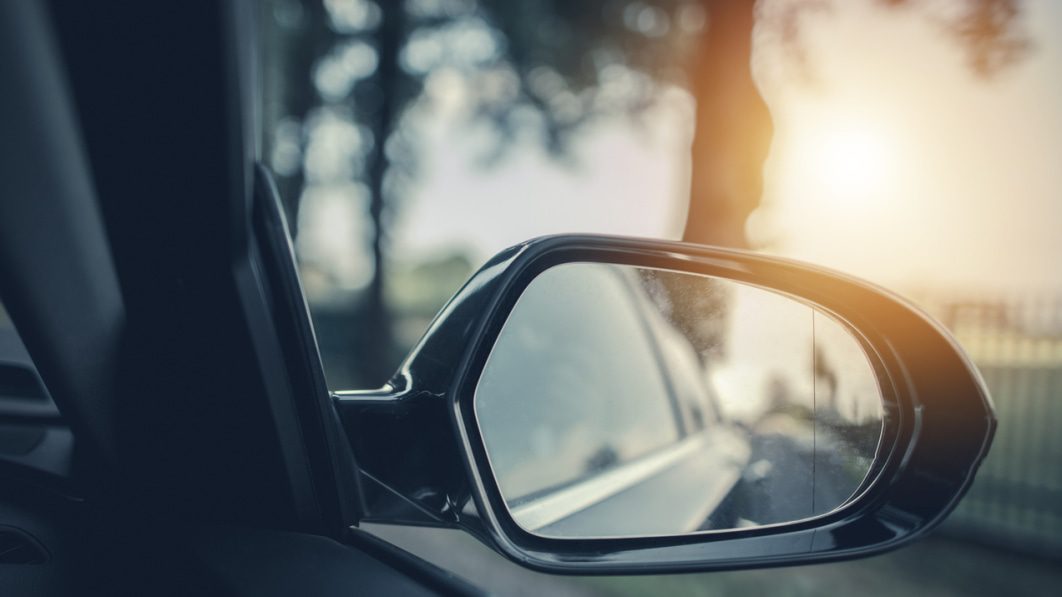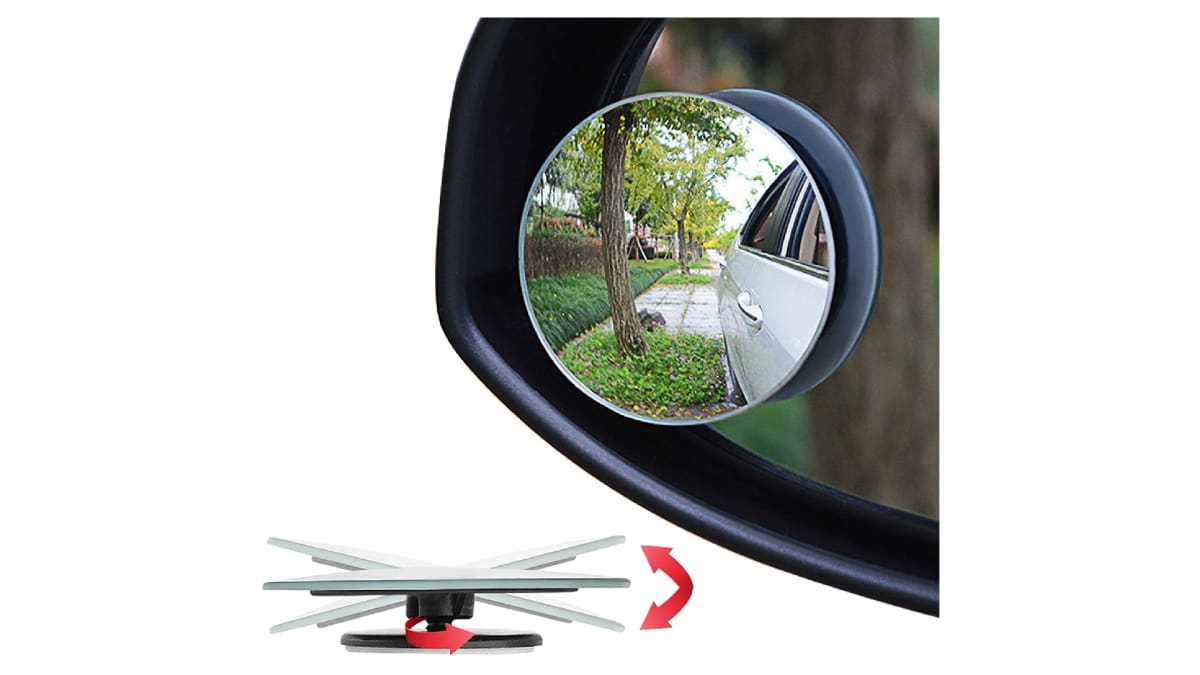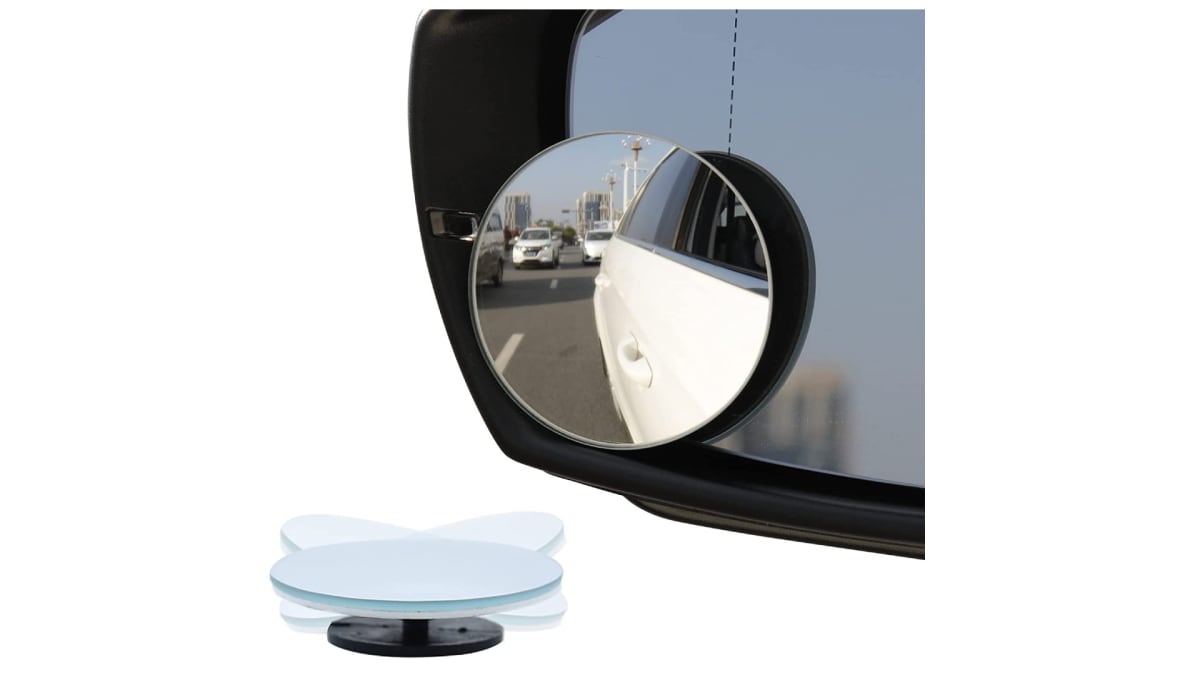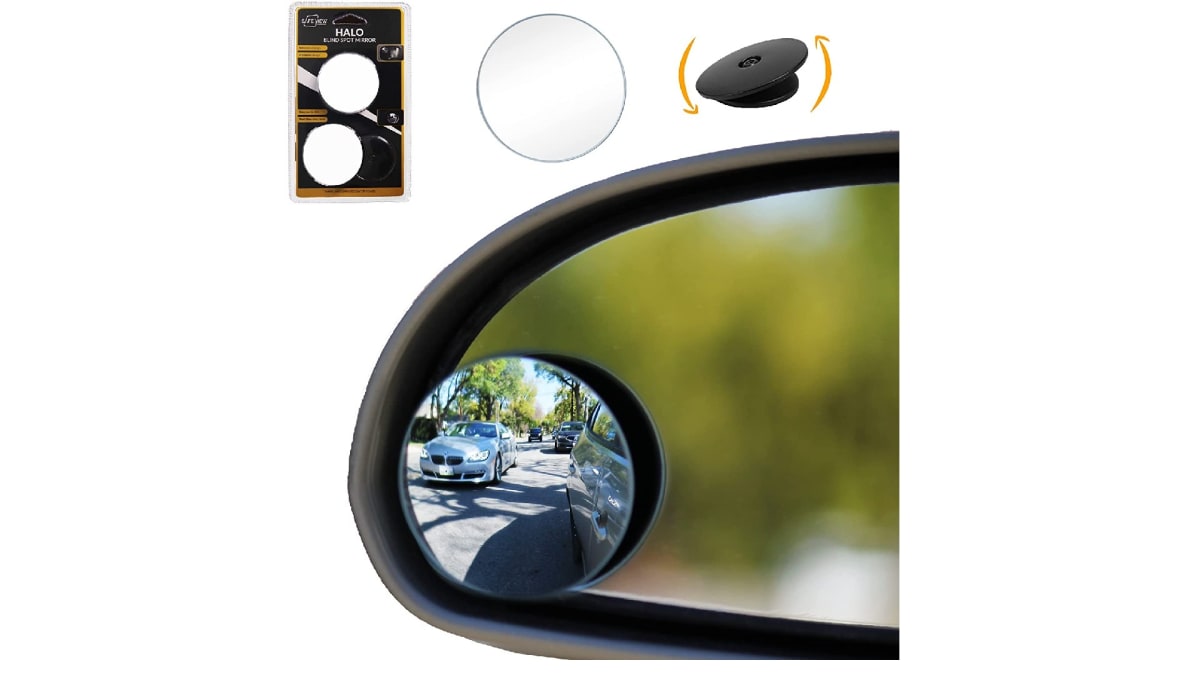Add some eyes to the back of your head with the top blind spot mirrors

Autoblog is not affiliated with the brands featured in our articles, but when you make a purchase through links on our site we may earn a commission.
Say goodbye to blind spots — check out our full list and buying guide of the leading blind spot mirrors that can help keep you aware of your surroundings while driving. You don’t want to have a blind spot when you’re pushing 60 to 80 mph on the highway, and even if you don’t plan on going that fast, you still need to know what’s going on around you on the roadways. Think of blind spot mirrors as an extra pair of eyes, or a piece of technology that you can use to augment your vision.
Say hello to blind spot mirrors. In this article, we’ll take a look at the leading blind spot mirrors, and also discuss what the phrase “blind spot” means and why it’s important for you to know where visibility might be lacking in your vehicle. Find out how important blind spot mirrors are and how much difference they can make, helping you to be alert and aware in the most delicate situations.
Top blind spot mirrors of 2022 reviewed in detail
Utopicar Blind Spot Mirrors: Premium pick
Buy on Amazon
Are you wondering why your vehicle doesn’t offer blind spot detection? Are you looking for a way to conveniently check what’s in your blind spot while driving? These Utopicar blind spot mirrors have a semi-oval design that’s less convex, providing a larger image of what’s behind and to the side of your car. The elongated style of these blind spot mirrors shows more of what’s occupying the near lane, as opposed to something like the sky or the sun. These highly reflective silver film mirrors feature a frameless design that will stick to your mirror no matter what. Quick question– what do you call a utopia without blind spots? With these blind spot mirrors the answer’s easy– your vehicle.
Pros
360-degree rotation and sway adjustable
Sleek semi-oval frameless design
Outdoor- and water-rated adhesive
Cons
Ampper Blind Spot Mirrors: Another great option

Buy on Amazon
If you drive a car (we’re gonna take a wild guess that you do), you don’t want to find yourself in the dark about what other drivers are doing on the road around you. A vehicle’s blind spot is a very dangerous area, by definition, it’s what you cannot see, even with the use of a rearview mirror, and this can leave you vulnerable behind the wheel. With these Ampper blind spot mirrors, though, you can help reduce that area. These 360-degree mirrors are sway-adjustable and feature a convex design for a greater field of view. An adjustable swivel-mounting bracket is included for quick installation, along with a 3M adhesive to stick those blind spot mirrors on nice and strong.
Pros
Offers 360-degree view
Convex design for a wide-angle view
Easy to install and adjust
Cons
Swivel mounts are prone to breakage over time
LivTee Blind Spot Mirrors: Stylish pick

Buy on Amazon
These LivTee blind spot mirrors come in a nice circular design, a set of two convex adjustable mirrors that are easy to install. These mirrors also have tiny adjustable swivel mounting brackets, allowing for easy adjustments if required. Circular blind spot mirrors are ideal for parking, but they just don’t offer as much of a view to the sides of the vehicle as other blind spot mirrors. While these blind spot mirrors sport a unique design, keep in mind that they’re still blind spot mirrors designed to assist your car’s side mirrors, not replace them. These circular blind spot mirrors are two inches in diameter, similar to most popular round mirrors, so they won’t take up too much mirror space.
Pros
Unique circular design
Waterproof and rust-resistant
Glass won’t glaze
Cons
Fit System C0400 Blind Spot Mirrors: Budget option

Buy on Amazon
These Fit System C0400 blind spot mirrors can give you some peace of mind every time a car or motorcycle brushes past you on the left. These adjustable mirrors offer a wide-angle view that can make blind spots a thing of the past, and they’re a universal fit, making them great for almost any car. These 2-inch mirrors are small and unassuming, and can even be used to place in the office or at your desk to give you a solid view of anything happening behind you. These blind spot mirrors are wallet-friendly, making them an even better choice– your safety is important, but why spend extra money when you don’t have to?
Pros
Neutralizes blind spots
Universal design, suitable for most cars
Adjustable mirror angle
Cons
A little on the small side
Halo Safe View Blind Spot Mirrors: Also consider

Buy on Amazon
Any time a vehicle passes us on the left, there’s always the risk of a collision if we don’t check our blind spots. These Safe View blind spot mirrors live up to their name and can do just that– give you a safe view of your blind spot. These blind spot mirrors are frameless and made of real glass, meaning that they won’t fade over time. They can make switching lanes and parking a breeze by giving you a full view of the lane or parking spot, and heavy-duty 3M adhesive is included for a strong, easy installation that you can rely on.
Pros
Glass mirrors for a clear image
Flexible and easy to install
Waterproof and rust-resistant
Cons
Buying guide: Blind spot mirrors
Blind spot mirrors can significantly increase your viewing angle and make it possible for you to keep a better eye on your vehicle’s blind spots — pretty handy, right? These accessories help improve the visibility level in your vehicle and can help you out with things like switching lanes and parking. Technology in the automotive industry is making enormous strides in terms of active and passive safety, but even with all the sensors and innovative inventions, driver responsibility and attention are paramount. Read our full buying guide to learn what blind spots are, the risks they pose, and how you can avoid them.
What is a car blind spot and where are they?
A blind spot, or blindspot, is a strip of road or external landscape whose visibility is blocked by an obstacle or is not reflected by a mirror. As for the direction of travel, those who drive a four-wheeled vehicle (typically cars or trucks) have a wide view forward and to the side, but their visibility is obstructed by the side pillars of their car, and this creates a dead angle, however small (or large) it may be. This is an obstacle that can be overcome fairly easily by turning your head until you have a clear view and can identify pedestrians or traffic coming from one side.
This forward blind spot problem does not arise for motorcycles, but difficulties do crop up when it comes to the rear of the vehicle– the only way for drivers to keep track of what’s happening behind them is through their rear-view mirrors, but these mirrors are not able to give a complete and uniform image.
Curved vs. flat mirrors
No matter the model (curved or flat), mirrors will always have their limits. Flat mirrors offer an accurate image with a limited viewing angle, while curved mirrors give a greater visual at the cost of offsetting proportions. The sad fact is that you’ll always have to deal with rearview mirror blind spots– even the rear of a car has side pillars that obstruct your view, and to see well diagonally, especially when maneuvering, the only way to achieve this is by turning around and swinging your head to change your point of view.
What is the dead angle of mirrors?
The dead angle of the mirror is the portion of the surrounding environment that doesn’t fit into the mirror and can be crucial in some driving phases, such as when you’re about to switch lanes and overtake a vehicle. To avoid a large dead angle, mirrors must be oriented to include a minimum portion of the car and a maximum of the exterior.
Blind corner
Car blind spots undoubtedly raise the issue of diagonal visibility. As long as you proceed straight ahead and there are no intersections, the problem won’t arise. If you reach a stop or an intersection, to avoid dead spots in front of you you’ll have to look left and right.
Another delicate situation is parking, in which you’ll often have to maneuver near other vehicles or areas frequented by pedestrians. This can be stressful, as there’s a constant risk (no matter how low) that something, or even someone, inadvertently enters the maneuvering area and is struck by the car and affected, either through injury or vehicular damage. This is why many cars are now equipped with parking sensors, making your life easier and giving you a good view of those rear blind spots.
What you need to know about overtaking
The most stressful moment for blind-spot monitoring is when overtaking another vehicle. Lane change requires maximum attention in the rear diagonal for any traffic from behind, but also in front for oncoming traffic and to keep a safe distance between you and the vehicle being overtaken. All mirrors have blind spots, so don’t simply trust the reflected image. This is why when overtaking you always have to quickly turn around in three directions– back, forward left (to exit the lane), then forward right to check to overtake distance, and finally back forward again to return.
Types of blind spot mirrors
There are numerous types of blind spot mirror designs, but the most common are round, half-round, oval, and square. These blind spot mirror designs are available with the following types of fasteners for clamping:
Mounted with suction cups or double-sided tape
These are attached directly to the reflective part of a standard car mirror, and the advantage of these is their low price.
Mounted with brackets or other fasteners
These are mounted above or below your car’s standard mirrors. The incline of these can often be adjusted according to the technical characteristics of the car, the height of the driver, and other factors.
Many manufacturers offer sets of two blind-angle mirrors, one for each side of your car. Most products are also universal, and they can be mounted both on cars, motorcycles, and even bicycles.
Tips for using blind spot mirrors
Prepare the reflective surface of your standard car mirror before mounting accessories with a suction cup or self-adhesive tape– clean, dry, and degrease the mirror with a special agent. Some manufacturers also recommend that you do not visit the car wash for several hours after installing your blind spot mirrors
It’s recommended to place the accessory in the farthest top corner of your car mirror, as this will increase your viewing angle
After mounting, make sure that the blind spot mirror is securely fastened and does not prevent the main mirror from being adjusted
Use special glass cleaners without abrasive components to clean your blind spot mirrors
Sensors and radar
Monitoring systems are also being developed for blind spots, and these can be quite helpful. A blind spot sensor is an increasingly popular assistance system that monitors blind spots in front of and around the side mirrors. It serves to cover that portion of the non-reflected space of the mirrors in which the risk of an accident is created at the very beginning of the overtaking phase. “Blind Spot Assist” is also very useful in case of light traffic coming from behind, such as motorcycles, bicycles, or pedestrians. This also helps to avoid changing direction too much, even while staying in the same lane, if there’s another vehicle nearby that’s not easy to spot. The various systems (the specific name will change depending on the make of the car) offer three types of warnings– a warning light (often found directly on the mirror), an acoustic signal, or a vibration system on the steering wheel. In some cases, this system only activates at speeds above 10 mph or in reverse.
How does proximity radar work?
Blind spot sensors are a form of proximity radar and work in a similar way to parking sensors. They’re sensors that send out radio waves and detect their responses– if an obstacle enters the emission field, the radio waves bounce off and return to the sensor, which measures its distance and position, just like submarine or aircraft radar.
Radar sensors
Radar sensors are also used in other systems (such as adaptive cruise control) to maintain a safe distance and adequate speed based on traffic. The range of the sensors used for the proximity space is around 500 feet, even if the alarm signal starts at much shorter distances than this (the range is greater because the object could be approaching rapidly). Distance measurement takes place by measuring the change in frequency modulation (Linear Frequency Modulation Shift Keying).
The frequency range is in the order of gigahertz (GHz) with a bandwidth of 200 megahertz (MHz) and a maximum power of 20-decibel milliwatts (dBm). The relative velocity can range from -70 to +70 meters per second, with an azimuth field of 165 degrees.
Conclusion
There are many dangers on the road, from blind spots to the risk of aquaplaning, but above all, the worst dangers arise from traffic. The overtaking phase is one of the most delicate parts of driving, and blind spots must be carefully checked to avoid the risk of an accident. Blind spot mirrors and even sensors, can be a great help, but don’t forget that the responsibility always lies with the driver first and foremost.
Blind Spot Mirror FAQs
Q: Should I choose blind spot mirrors constructed from aluminum rather than plastic?
Depending on where you live and the conditions of where you store your car, you may want to pay a little extra for aluminum blind spot mirrors so they don’t degrade as quickly as plastic units. For most car owners, however, this is a very minor aspect when choosing the right blind spot mirrors.
Q: What is the difference between adjustable and non-adjustable blind spot mirrors?
Some blind spot mirrors are adjustable, allowing you to angle or turn them to broaden your view. Adjustable blind spot mirrors may cost a bit more, but the added versatility is often worth the extra cost.
Q: Where are the blind spot areas of a motorcycle?
The blind spot areas vary according to the type of motorcycle and mirrors used– unfortunately, there’s no simple answer. Some riders may have special mirrors to help reduce their bike’s blind spot, and this can be a very beneficial addition that can greatly improve the rider’s safety.



